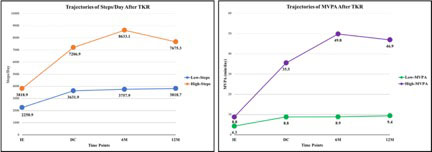Session Information
Session Type: Poster Session D
Session Time: 1:00PM-3:00PM
Background/Purpose: Total knee replacement (TKR) is the definitive treatment for adults with knee osteoarthritis (OA) and is often successful in reducing pain and improving function. However, most adults fail to meet recommended levels of physical activity (PA) even after TKR surgery, which places them at risk for diabetes, cardiovascular disease, and premature death. Presurgical PA may be a critical driver of postsurgical PA, though at present little is known about this relationship. Therefore, the purpose of this study was to explore the association of patient reported presurgical PA with postsurgical trajectories of steps/day and moderate-to-vigorous intensity physical activity (MVPA) over one year.
Methods: We conducted a secondary analysis of a null study randomizing adults after TKR to either a Physical Therapy (PT) plus a physical therapist-administered PA intervention or PT alone. We included adults ≥ 45 years with a unilateral TKR, and excluded those unable to participate in a PA intervention. We assessed presurgical PA at baseline by asking “What was your pre-injury spare-time activity level?”. Choices included 1) inactive –hardly any PA, reading or watching TV 2) mildly active – walk 2-3 times/week, gardening or sports 3) moderate active – at least 3 hours of exercise per week such as jogging, handball, tennis 4) very active – train intensively for rigorous PA 4 to 6 hours a week or more. We dichotomized the responses into: Less Active Before TKR (1 or 2) vs. More Active Before TKR (3 or 4). Steps/day and MVPA were assessed using an Actigraph GT3X monitor, worn for 7 days at baseline (IE), discharge from PT (DC), and 6 and 12 months after DC from PT (6M and 12M). We included participants who provided presurgical PA and wore the Actigraph at IE and for ≥ 2 follow up visits, e.g., DC, 6M and/or 12M. We used a Group Based Trajectory Method (PROC TRAJ) to classify participants into trajectory groups for steps/day and MVPA over 12 months. To explore the association of presurgical PA with membership in trajectory groups, we used multinomial logistic regression to calculate odds ratios (OR) and 95% confidence intervals (95% CI), adjusted for age, sex and body mass index in separated models.
Results: We included 98 participants (mean age 66.4 ± 7.3 years, 54.1% female, mean BMI 32.2 ± 6.8 kg/m2). See Table. Two trajectory groups were found for steps/day and MVPA (Figure). Those who were More Active Before TKR were 3.2 times more likely to be in the “High-Steps” group and 3.0 times more likely to be in the “High-MVPA” group after TKR, compared to those were Less Active Before TKR (OR = 3.2, 95% CI[1.2, 8.7], for steps/day, and OR = 3.0, 95% CI[1.0, 8.7], for MVPA).
Conclusion: Presurgical activity may be an important predictor of trajectories of PA one year after TKR. Future PA interventions may consider targeting those with low presurgical levels of activity, since these individuals are unlikely to increase activity after surgery and continue to have low levels of PA.
Abbreviations: IE, baseline; DC, discharge from PT; 6M, 6 months after discharge from PT; 12M, 12 months after discharge from PT; PT, Physical Therapy.
To cite this abstract in AMA style:
Aily J, Voinier D, Jakiela J, Bye T, Master H, Thoma L, White D. Does Exercise Before Surgery Predict Trajectories of Physical Activity After Knee Replacement? [abstract]. Arthritis Rheumatol. 2022; 74 (suppl 9). https://acrabstracts.org/abstract/does-exercise-before-surgery-predict-trajectories-of-physical-activity-after-knee-replacement/. Accessed .« Back to ACR Convergence 2022
ACR Meeting Abstracts - https://acrabstracts.org/abstract/does-exercise-before-surgery-predict-trajectories-of-physical-activity-after-knee-replacement/


